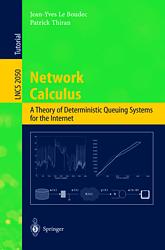Network Calculus
The book

The Network Calculus book by Jean-Yves Le Boudec and Patrick
Thiran is available for free download: part
I (PDF), parts II and III (PDF).
It is also available soon as Springer-Verlag
Lecture Notes on Computer Science number 2050. We are very
grateful to Springer-Verlag for this generous arrangement.
What is Network Calculus ?
Network Calculus is a collection of results based on Min-Plus
algebra, which applies to deterministic queuing systems found in
communication networks. It can be used for example to understand
- the computations for delays used in the IETF guaranteed
service
- why re-shaping delays can be ignored in shapers or
spacer-controllers
- a common model for schedulers
- deterministic effective bandwidth
- and much more.
If
you want to learn more about this exciting topic, read the Network
Calculus book. It is available for free download.
Network Calculus is also the name of a project at EPFL/ICA.
About this page:
This page contains pointers to :
- results of the EPFL project called "network calculus"
- state of the art material related to the project.
This page is maintained at http://ica1www.epfl.ch/PS_files/NetCal.htm
by jean-yves.leboudec@epfl.ch.
If you would like to contribute with a pointer, please send me an
email.
References
Four sources introduced in parallel the concepts of service curve.
These are:
- H. Sariowan, R. L. Cruz, and G. C. Polyzos, "Scheduling for
Quality of Service Guarantees via Service Curves," Proceedings of
the International Conference on Computer Communications and
Networks (ICCCN) 1995, Las Vegas, September 20-23, 1995, pp.
512-520. Full
paper (211K,postscript).
- "Application
of Network Calculus To Guaranteed Service Networks", JY Le
Boudec, IEEE Trans on Information theory, (44) 3, May 1998
(introductory material)
- "On deterministic traffic regulation and service guarantee:
Asystematic approach by filtering", IEEE TIT vol 44, May 98, pp
913--931. One of the papers which introduced (in parallel to
Agrawal, Cruz, Okino, Rajan on one hand, Le Boudec on the other
hand) the concepts of service curve. Uses the language of
filtering theory, or traditional linear systems. Unlike the other
authors mentioned above, uses discrete time, which simplifies the
approach, probably without any loss of generality (we call this
the time method, as opposed to the space method).
- "
Performance Bounds for Flow Control Protocols", R. Agrawal, R.
L. Cruz, C. Okino and R. Rajan, IEEE ToN vol 7, No3, June 99, pp
310--323. " The service curve theory, applied to flow control
protocols.
The four papers above were based on
Cruz's original contribution, which itself built upon the service
curve concept introduced by Parekh and Gallager:
- Parekh, A. K., & Gallager, R. G., "A Generalized Processor
Sharing Approach to flow control in Integrated Services Networks -
The Multiple Node Case," IEEE/ACM Transactions on Networking, Vol
2 #1, pp 137-150, April 1994. Contains the seminal definition of
service curves.
- R. L. Cruz, "Quality of Service Guarantees in Virtual Circuit
Switched Networks," IEEE Journal of Selected Areas in
Communication, special issue on "Advances in the Fundamentals
of Networking" (vol. 13 no. 6), August, 1995 Full
paper (529K,postscript). First attempt to generalize Parekh,
A. K., & Gallager's service curve.
More:
- H. Sariowan, "A Service-Curve Approach to Performance
Guarantees in Integrated-Service Networks," Ph.D. thesis,
Department of Electrical & Computer Engineering, UCSD, June,
1996. Full
thesis (1M,postscript).
- "SCED+. Efficient Management of Quality of Service
Guarantees", R.L. Cruz, Proc Infocom 98, March 1998
Introduces the concept of "maximum service curve". Applies to a
method for guaranteeing end to end bounds on delay jitter, using
the SCED+ scheduling method. With SCED+, every packet carries
information about its lateness and nodes delay packets that are
too early. A benefit is for best effort traffic which then gets
lower delay. Introduces the concept of "damper".
- R. Agrawal, F.
Baccelli, R. Rajan, `` An Algebra for
Queueing Networks with Time Varying Service and its application to
the analysis of integrated service networks,'' Technical
Report ECE-98-2, ECE Dept., University of Wisconsin - Madison, May
1998. (Also INRIA
Report 3435.)
- Stochastic Aspects: a starting point is R. Boorstyn, A.
Burchard, J. Liebeherr, and C. Oottamakorn, University of
Virginia, Department of Computer Science, CS-99-21, July 1999:
Statistical
Multiplexing Gain of Link Scheduling Algorithms in QoS
Networks
pages copied from: http://lcawww.epfl.ch/Publications/LeBoudec/LeBoudecT01a.htm

